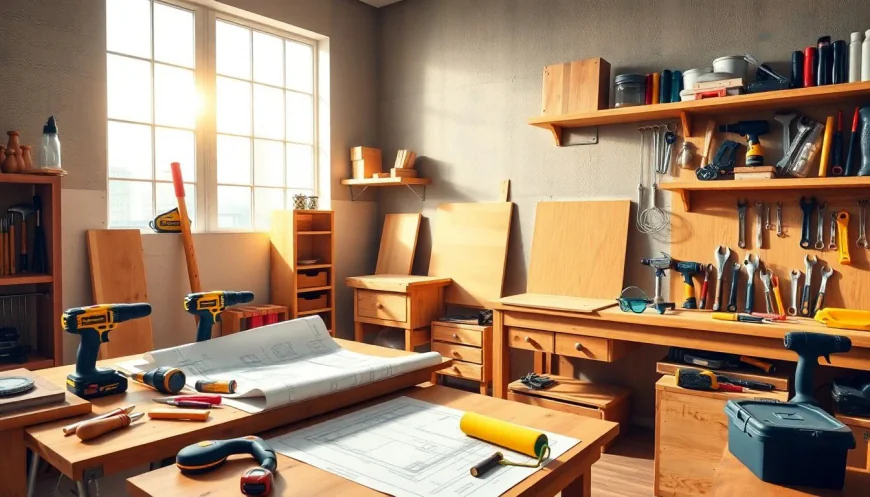Essential Home Improvement Tools: The Ultimate Guide to Upgrading Your Space
Every successful home project starts with the right tools. Whether you’re hanging shelves, fixing a leaky faucet, or remodeling a room, having the proper equipment makes all the difference. Proper tools save you time, prevent accidents, and help you get quality results. From basic repairs to advanced DIY projects, knowing which tools to keep in your toolbox is the key to becoming a confident homeowner or hobbyist.

Why Investing in Quality Home Improvement Tools Matters
Benefits of High-Quality Tools
Choosing good tools isn’t just about bragging rights. Durability is a big plus — high-quality tools last longer and stand up better to tough jobs. They also give you better control, leading to more precise work and fewer accidents. Plus, investing upfront may seem costly but saves money in the long run since replacements are rarely needed. Good tools reduce frustration and make projects smoother.
Common Mistakes When Choosing Tools
Many homeowners fall into traps by buying cheap tools that break easily. It’s tempting to grab low-price options, but they often don’t get the job done. Picking the wrong tool for a specific task can slow progress or damage materials. Also, skimping on safety gear like goggles or gloves leaves you vulnerable to injuries. The right tools paired with proper safety measures make all the difference in quality and safety.
Essential Power Tools for Every Homeowner
Cordless Drills and Impact Drivers
A versatile must-have, cordless drills handle drilling, screwing, and fastening tasks. Look for models with longer battery life, more torque, and a comfortable grip. Impact drivers pack more power for tougher jobs, like assembling furniture or installing deck boards. Remember, features like quick-chuck systems and LED lights help you work faster and safer.
Circular Saws and Jigsaws
Cutting is a major part of many home upgrades, and these saws make it easier. Circular saws are perfect for straight cuts through wood or laminate, while jigsaws excel at curved or intricate shapes. Always prioritize safety by wearing goggles and keeping blades sharp. Proper technique prevents splintering and accidents.
Sander and Grinder Tools
Finish rough surfaces or prepare materials with a sander. Random orbit sanders are ideal for smooth surfaces, while belt sanders quickly remove material. Grinders, on the other hand, cut through metal or sharpen tools. Use the right pad or disc for your task and always wear protective gear to avoid injuries.
Recommendations for Top Brands and Models
Trusted brands like DeWalt, Makita, and Bosch make reliable power tools backed by user reviews and expert opinions. For instance, the DeWalt DCD771Cordless Drill offers excellent battery life and durability. When choosing models, consider your project scope and your budget — quality tools may cost more initially but pay off with performance.
Hand Tools You Should Have in Your Home Toolbox
Basic Hand Tools
Every toolbox needs fundamental tools like a hammer, screwdriver set, pliers, and a tape measure. These are your go-to for quick fixes or simple projects. Keep tools clean and sharpen blades regularly to extend their life.
Specialized Tools for Specific Projects
Certain tasks require precision tools — a level helps you hang items straight, while a square ensures corners are perfect. Utility knives cut through drywall or cardboard. Chisels and pry bars are useful for demo work. A good measuring tape ensures accuracy every time.
Maintenance and Storage
Proper care boosts your tools’ lifespan. Clean dirt and dust after each job, sharpen blades, and oil moving parts. Store everything in an organized toolbox or wall-mounted rack, so your tools stay in good shape and are easy to find when needed.
Safety Equipment and Accessories
Personal Protective Equipment (PPE)
Always wear safety glasses or goggles to guard your eyes. Gloves protect your hands during tough jobs. Dust masks keep debris out of your lungs, especially when sanding or cutting. Never ignore safety gear — it’s your best defense against injuries.
Tool Accessories and Attachments
Replace drill bits, blades, and sanding pads regularly for best results. When switching parts, follow the manufacturer's instructions for a secure fit. Using the right accessory on your tools improves efficiency and safety.
Safe Work Practices
Read manuals thoroughly before operating any new tools. Keep your workspace clean, dry, and well-lit. Take your time, and don’t rush through tasks. A cautious approach prevents accidents and ensures better project outcomes.
Tips for Choosing and Buying Home Improvement Tools
Assessing Your Project Needs
Start by thinking about what projects you want to do. Do you need tools for small repairs or big renovations? Make a list of essential items to avoid buying unnecessary gear, and focus your budget on versatile, high-quality tools.
Budget-Friendly Purchase Strategies
Invest in top brands that guarantee quality, but don’t buy everything at once. Consider second-hand tools or renting for occasional use. Quality tools save money over time because they last longer and perform better.
Trusted Retailers and Brands
Shop from reputable stores or online platforms known for authentic products. Popular brands include Milwaukee, Black & Decker, and Ryobi. Read reviews and ratings before making a purchase, to ensure reliability and performance.
Conclusion
Picking the right home improvement tools is vital for successful projects. High-quality equipment makes your work safer, faster, and more professional. Keep your tools well-maintained and always prioritize safety. Staying informed about new tools and techniques helps you improve with each project. Now, go ahead — transform your home one tool at a time!



 VARSHITHA
VARSHITHA